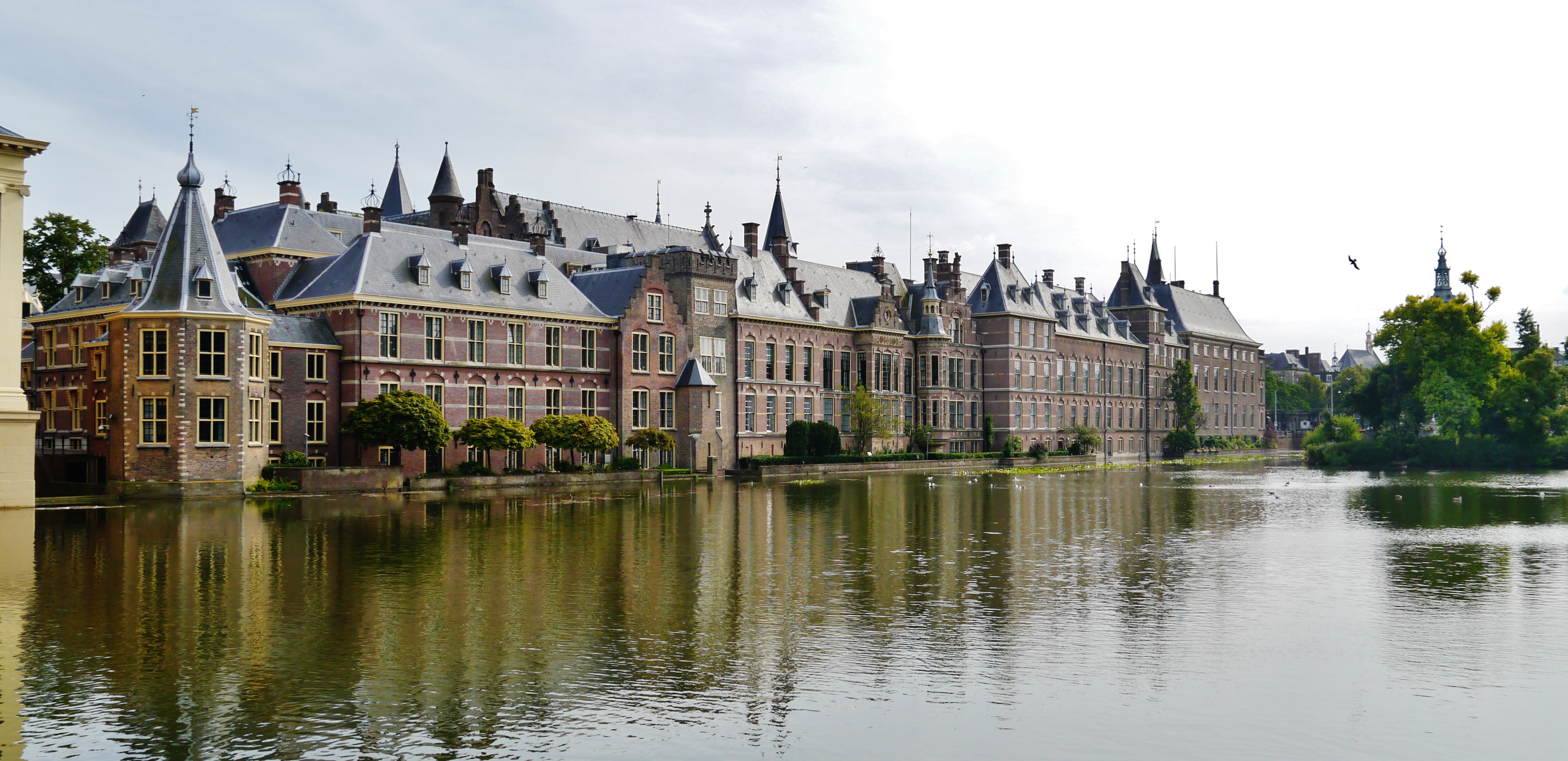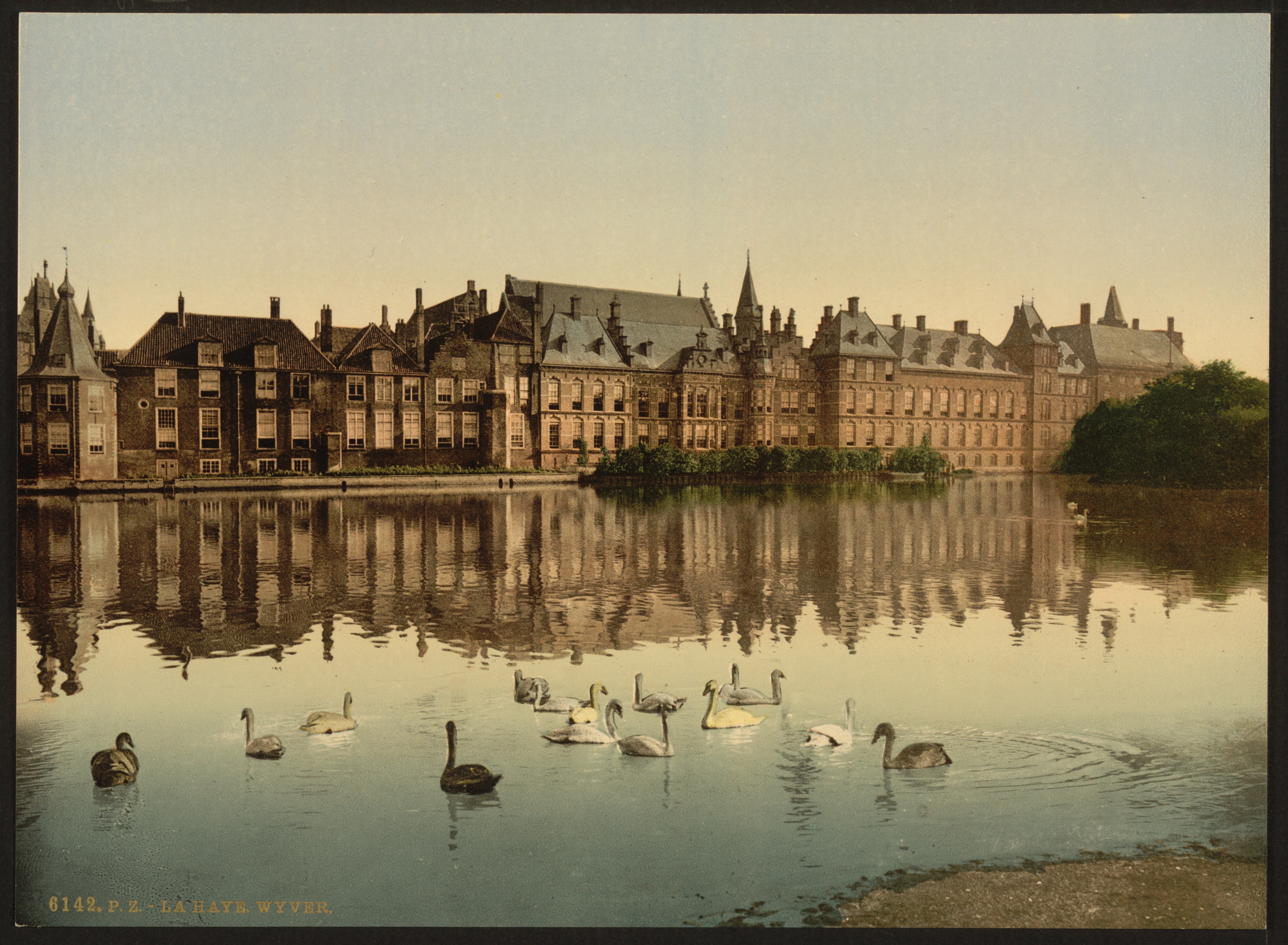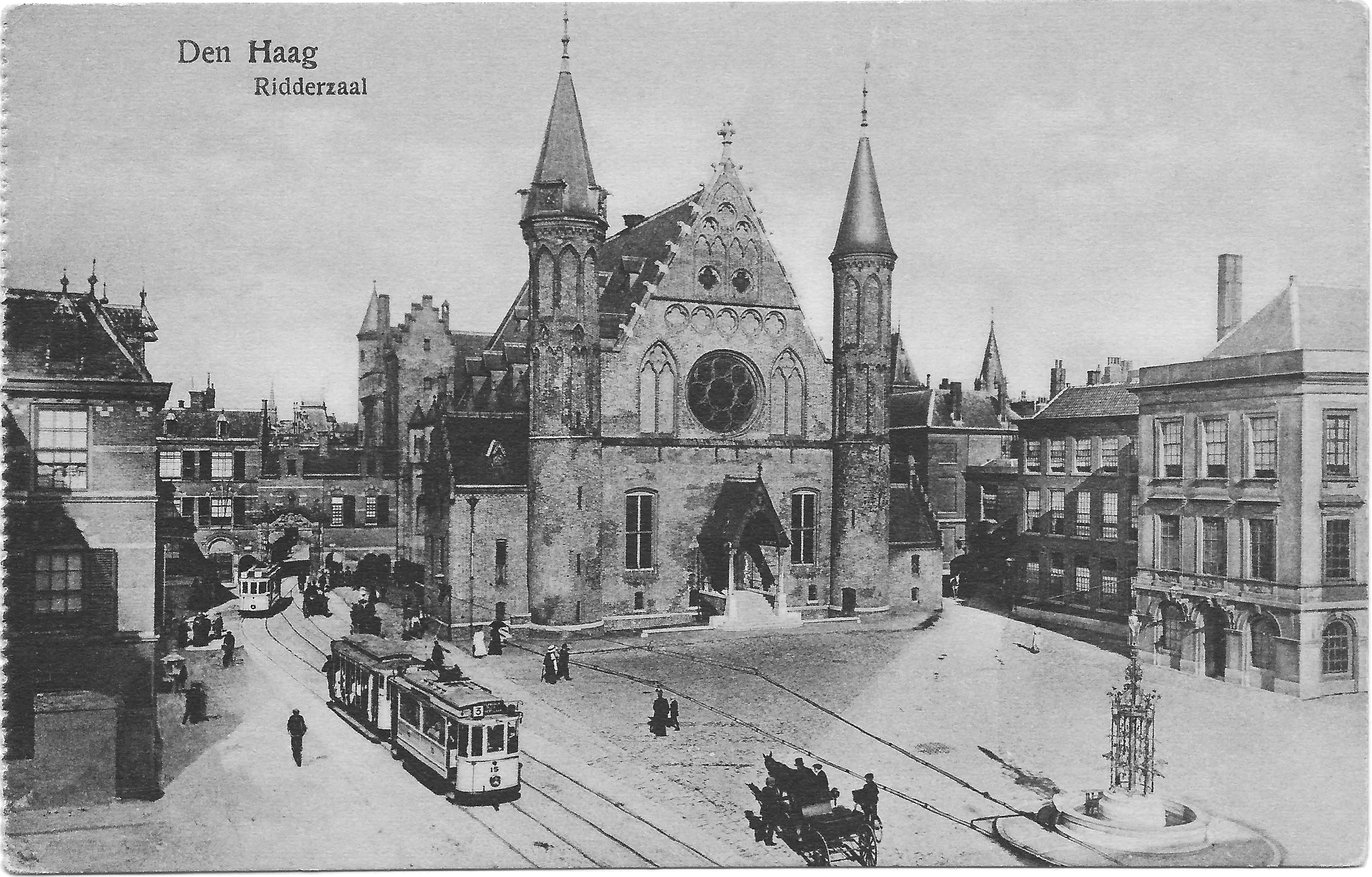|
Binnenhof
The Binnenhof (; en, Inner Court) is a complex of buildings in the city centre of The Hague, Netherlands, next to the Hofvijver lake. It houses the meeting place of both houses of the States General of the Netherlands, as well as the Ministry of General Affairs and the office of the Prime Minister of the Netherlands. Built primarily in the 13th century, the Gothic castle originally functioned as residence of the counts of Holland and became the political centre of the Dutch Republic in 1584. It is counted among the Top 100 Dutch heritage sites. The Binnenhof is among the oldest Parliament buildings in the world still in use. History Little is known about the origin of the Binnenhof. Presumably, the grounds next to the Hofvijver lake, and the small homestead on it, were purchased by Count Floris IV of Holland from Meiland van Wassenaar in November 1229. Between 1230 and 1234 he had the homestead expanded to a small keep. After Floris' son and successor William II was cr ... [...More Info...] [...Related Items...] OR: [Wikipedia] [Google] [Baidu] |
The Hague
The Hague ( ; nl, Den Haag or ) is a city and municipality of the Netherlands, situated on the west coast facing the North Sea. The Hague is the country's administrative centre and its seat of government, and while the official capital of the Netherlands is Amsterdam, The Hague has been described as the country's de facto capital. The Hague is also the capital of the province of South Holland, and the city hosts both the International Court of Justice and the International Criminal Court. With a population of over half a million, it is the third-largest city in the Netherlands, after Amsterdam and Rotterdam. The Hague is the core municipality of the Greater The Hague urban area, which comprises the city itself and its suburban municipalities, containing over 800,000 people, making it the third-largest urban area in the Netherlands, again after the urban areas of Amsterdam and Rotterdam. The Rotterdam–The Hague metropolitan area, with a population of approximately 2.6&n ... [...More Info...] [...Related Items...] OR: [Wikipedia] [Google] [Baidu] |
Hofvijver
The Hofvijver (; en, Court Pond) is a lake in the centre of The Hague, Netherlands. It is adjoined in the east by the Korte Vijverberg (road), in the south by the Binnenhof and the Mauritshuis, in the west by the Buitenhof and in the north by the Lange Vijverberg (road). In the middle there is a small island with plants and trees which has no name, it is usually referred to as "the island in the Vijverberg". History The term pond is actually a misnomer, as the Hofvijver has its origin in a natural dune lake fed by the Haagse Beek (Hague Creek, originally Dunecreek) and the, nowadays muted, Bosbeek (Forestcreek) from the Haagse Bos (Hague Forest). The Haagse Beek still feeds the Hofvijver and so the pond is directly connected to the dunes in Kijkduin. In this dune lake there was an island (not the current island in the Hofvijver) on which Willem II built his palace in 1248. Other sources say he built his palace alongside the pond and created a moat around it. The city o ... [...More Info...] [...Related Items...] OR: [Wikipedia] [Google] [Baidu] |
Ridderzaal
The Ridderzaal (; en, Hall of Knights) is the main building of the 13th-century inner square of the former castle of the counts of Holland called Binnenhof (English: Inner Court) at the address Binnenhof 11 in The Hague, Netherlands. It is used for the annual state opening of Parliament on Prinsjesdag, when the Dutch monarch drives to Parliament in the Golden Coach and delivers the speech from the throne. It is also used for official royal receptions, and inter-parliamentary conferences. History In the 13th century Floris IV, Count of Holland bought a piece of land next to a small lake to build a house on. The Ridderzaal, the manorial hall of Floris V, grandson of Floris IV, was built on this estate in the 13th century. Over the centuries, the government buildings developed around this lake and incorporated the Ridderzaal. From the early 17th century, the Ridderzaal became an important trading place for booksellers, as Westminster Hall was in London. In later centuries it se ... [...More Info...] [...Related Items...] OR: [Wikipedia] [Google] [Baidu] |
States General Of The Netherlands
The States General of the Netherlands ( nl, Staten-Generaal ) is the supreme bicameral legislature of the Netherlands consisting of the Senate () and the House of Representatives (). Both chambers meet at the Binnenhof in The Hague. The States General originated in the 15th century as an assembly of all the provincial states of the Burgundian Netherlands. In 1579, during the Dutch Revolt, the States General split as the northern provinces openly rebelled against Philip II, and the northern States General replaced Philip II as the supreme authority of the Dutch Republic in 1581. The States General were replaced by the National Assembly after the Batavian Revolution of 1795, only to be restored in 1814, when the country had regained its sovereignty. The States General was divided into a Senate and a House of Representatives in 1815, with the establishment of the United Kingdom of the Netherlands. After the constitutional amendment of 1848, members of the House of Representatives w ... [...More Info...] [...Related Items...] OR: [Wikipedia] [Google] [Baidu] |
Ministry Of General Affairs
, type = Department , logo = Ministerie van Algemene Zaken Logo.png , logo_width = 250x250px , logo_caption = Logo of the Ministry of General Affairs , image = Ministerie Algemene Zaken - Binnenhof.JPG , image_size = 250x250px , image_caption = Building of the Ministry of General Affairs , formed = , jurisdiction = Kingdom of the Netherlands , headquarters = Binnenhof 19, The Hague, Netherlands , employees = 400 , budget = €1.4 million (2018) , minister1_name = Mark Rutte , minister1_pfo = Minister of General Affairs , minister2_name = , minister2_pfo = , deputyminister1_name = , deputyminister1_pfo = , chief1_name = Paul Huijts , chief1_position = Secretary-General , deputy = , website Ministry of General Affairs The Ministry of General Affairs ( ... [...More Info...] [...Related Items...] OR: [Wikipedia] [Google] [Baidu] |
House Of Representatives (Netherlands)
The House of Representatives (, pronounced ; commonly referred to as the ', literally "Second Chamber of the States General") is the lower house of the bicameral parliament of the Netherlands, the States General, the other one being the Senate. It has 150 seats, which are filled through elections using party-list proportional representation. Generally, the house is located in the Binnenhof in The Hague, however, it has temporarily moved to the former building of the Ministry of Foreign Affairs at Bezuidenhoutseweg 67 in the Hague while the Binnenhof is being renovated. Name Although the body is officially called the "House of Representatives" in English, it is not a direct translation of its official Dutch name, the "Second Chamber of the States General", "Second Chamber" or more colloquially just the "Chamber". Rather than "representative" (''afgevaardigde''), a member of the House is referred to as ''(Tweede) Kamerlid'', or "member of the (Second) Chamber". Functions Th ... [...More Info...] [...Related Items...] OR: [Wikipedia] [Google] [Baidu] |
Prime Minister Of The Netherlands
The prime minister of the Netherlands ( nl, Minister-president van Nederland) is the head of the executive branch of the Government of the Netherlands. Although the monarch is the ''de jure'' head of government, the prime minister ''de facto'' occupies this role as the officeholder chairs the Council of Ministers and coordinates its policy with the rest of the cabinet. The current prime minister has been Mark Rutte since 14 October 2010, whose fourth cabinet was inaugurated on 10 January 2022. History Gradually the prime minister became an official function of government leader, taken by the political leader of the largest party. Since 1845, the role of the first minister is relevant. In that year the Constitution of the Netherlands was amended to make ministers responsible to the States General and no longer responsible to the king, who acted as the leader of cabinet. Until 1901, the position chair of the Council of Ministers officially rotated between ministers. Between 19 ... [...More Info...] [...Related Items...] OR: [Wikipedia] [Google] [Baidu] |
Prinsjesdag
Prinsjesdag ( en, Little Prince's Day) is the day on which the reigning monarch of the Netherlands addresses a joint session of the States-General of the Netherlands (consisting of the Senate and the House of Representatives) to give the speech from the throne ( nl, Troonrede, similar to the annual US State of the Union). This speech sets out the main features of government policy for the coming parliamentary session. The occasion is prescribed by the constitution, article 65 of which states: "A statement of the policy to be pursued by the Government shall be given by or on behalf of the King or the Queen before a joint session of the two Houses of the States-General that shall be held every year on the third Tuesday in September or on such earlier date as may be prescribed by Act of Parliament." After the speech from the throne, the budget is later presented to the House of Representatives by the Minister of Finances. Speech from the Throne The first part of Prinsjes ... [...More Info...] [...Related Items...] OR: [Wikipedia] [Google] [Baidu] |
Top 100 Dutch Heritage Sites
The Top 100 Dutch heritage sites is a list of rijksmonuments in the Netherlands, established in 1990 by the Department for Conservation ( Monumentenzorg, today the Rijksdienst voor het Cultureel Erfgoed). The Top 100 was a selection of historical monuments that were authorized to display the symbol of the Hague Convention of 1954 (the famous blue and white shield, known as the UNESCO shield). The list should not be confused with the UNESCO World Heritage list. The buildings on the list could expect extra security in the context of the policy. The Top 100 list is no longer official, as the extra cultural protection policy is no longer applied. The following Top 100 also includes a list of the most important stained glass, church bells and organs. {, class="wikitable sortable" ! Object !! Built !! Place !! Province !! class="unsortable" , Image , - , Saint Bavo Church , , , , Aardenburg , , ZE , , , - , Castle Amerongen , , 1676 , , Amerongen , , UT , , , - , Ameri ... [...More Info...] [...Related Items...] OR: [Wikipedia] [Google] [Baidu] |
William II Of Holland
William II (February 1227 – 28 January 1256) was the Count of Holland and Zeeland from 1234 until his death. He was elected anti-king of Germany in 1248 and ruled as sole king from 1254 onwards. Early life William was the eldest son and heir of Count Floris IV of Holland and Matilda of Brabant.M. A. Pollock, Scotland, ''England and France After the Loss of Normandy, 1204-1296'', (The Boydell Press, 2015), xv. When his father was killed at a tournament at Corbie, William was only seven years old. His paternal uncles William and Otto, bishop of Utrecht, were his guardians until 1239. Kingship With the help of his maternal uncle Duke Henry II of Brabant and the Cologne archbishop Konrad von Hochstaden, William was elected king of Germany after Emperor Frederick II was excommunicated by Pope Innocent IV. He succeeded Landgrave Henry Raspe of Thuringia who had died within a year after his election as anti-king in 1246. The next year, William decided to extend his father's huntin ... [...More Info...] [...Related Items...] OR: [Wikipedia] [Google] [Baidu] |
Great Hall
A great hall is the main room of a royal palace, castle or a large manor house or hall house in the Middle Ages, and continued to be built in the country houses of the 16th and early 17th centuries, although by then the family used the great chamber for eating and relaxing. At that time the word "great" simply meant big and had not acquired its modern connotations of excellence. In the medieval period, the room would simply have been referred to as the "hall" unless the building also had a secondary hall, but the term "great hall" has been predominant for surviving rooms of this type for several centuries, to distinguish them from the different type of hall found in post-medieval houses. Great halls were found especially in France, England and Scotland, but similar rooms were also found in some other European countries. A typical great hall was a rectangular room between one and a half and three times as long as it was wide, and also higher than it was wide. It was entered ... [...More Info...] [...Related Items...] OR: [Wikipedia] [Google] [Baidu] |
Netherlands
) , anthem = ( en, "William of Nassau") , image_map = , map_caption = , subdivision_type = Sovereign state , subdivision_name = Kingdom of the Netherlands , established_title = Before independence , established_date = Spanish Netherlands , established_title2 = Act of Abjuration , established_date2 = 26 July 1581 , established_title3 = Peace of Münster , established_date3 = 30 January 1648 , established_title4 = Kingdom established , established_date4 = 16 March 1815 , established_title5 = Liberation Day (Netherlands), Liberation Day , established_date5 = 5 May 1945 , established_title6 = Charter for the Kingdom of the Netherlands, Kingdom Charter , established_date6 = 15 December 1954 , established_title7 = Dissolution of the Netherlands Antilles, Caribbean reorganisation , established_date7 = 10 October 2010 , official_languages = Dutch language, Dutch , languages_type = Regional languages , languages_sub = yes , languages = , languages2_type = Reco ... [...More Info...] [...Related Items...] OR: [Wikipedia] [Google] [Baidu] |






.jpg)
